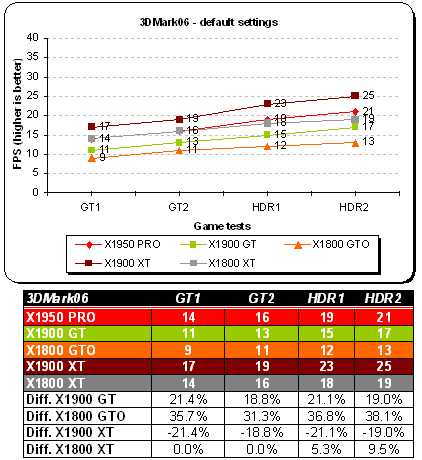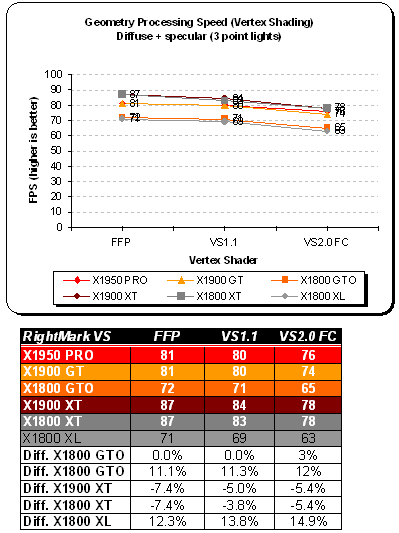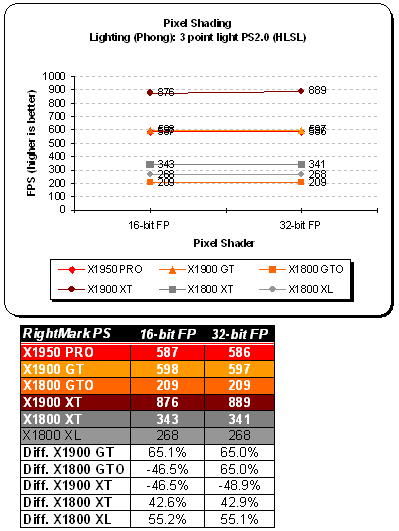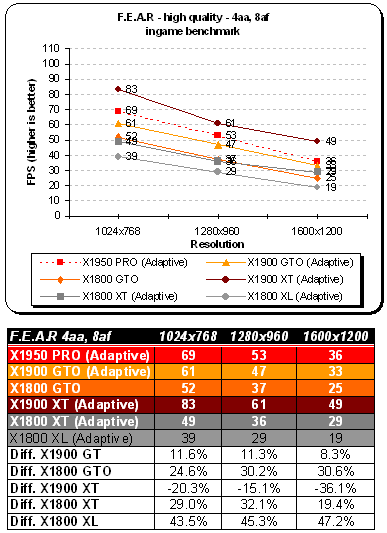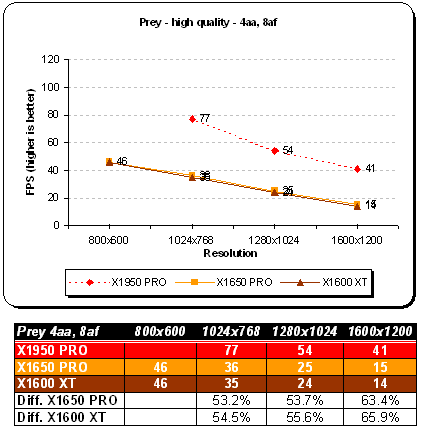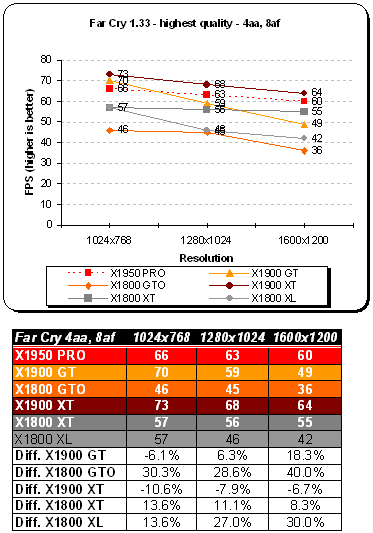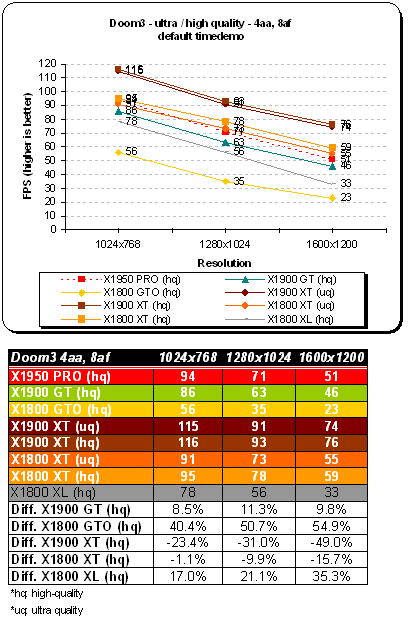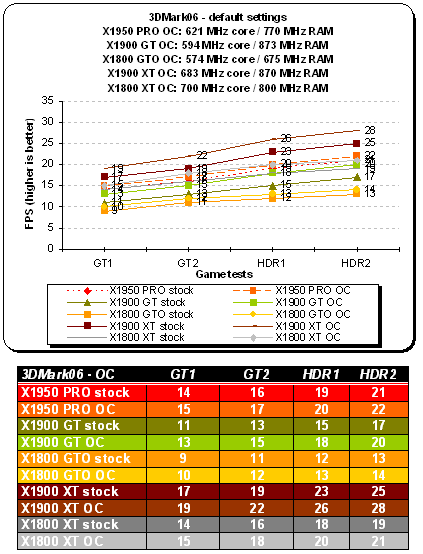If you were to buy X1800 XT, but don’t have enough money get X1950 PRO with native CrossFire support. Later on get another one of those and you’ll be set for a long time. RADEON X1950 PRO is NOT a respin. PowerColor X1950 PRO 256MB is a steal for $229. It plays my games smoothly, it’s quiet and cool and I can buy another one of those without the need for external dongle or master card
80 nanometer here I come
Quite a lot of new SKUs from ATI this year. Most are just renames with small changes if any. Obviously ATI wants to get rid of their older chips and brand them differently. The last of DX9 cards just came out so we shouldn’t see newer SKUs popping on the market. NVIDIAs G80 and its DX10 support is around the corner, ATI is doing their thing with R600 nevertheless you probably won’t see it before G80.
Beginning of 2006 until now was all about 90 nm chips. Just recently ATI released their first .08µ chips codenamed R580+ (Don’t get fooled though; R580 is X1900 XT, meaning it’s been out but manufactured using 90 nm process, the plus sign is my own remark to distinguish the two) and RV535 (X1650). Throughout this year the company brought us many interesting products with phenomenal performance / price ratio: X1650 PRO, X1900 GT, X1800 GTO to name a few. Die shrink to 80 nm was just an experiment before ATI rolls out the big (small) guns based on 65 nm silicon. On October 17th ATI had released RV570, X1950 PRO also based on 80 nm process. The chip itself brings nothing new as it’s heavily based on R580+. To be frank it’s basically X1900 GT with faster clocks, internal Crossfire support and cheaper price tag.
Internal CrossFire support
Until now all higher-end RADEONs used special compositing chip with the need of CrossFire master card to operate properly. The X1950 PRO brings a slight, but healthy change. Instead of using external compositing chip, dongle as well as master/slave card ATI incorporated CrossFire support into the GPU. It’s definitely the easiest approach with less complications for the end user. It does seem a lot like NVIDIA’s SLI bridge solution with minor difference — there are two connectors on the PCB instead of just one. Does any of this ring a bell to you? Daisy chained graphic cards is the answer. Although implementing an internal compositing engine adds costs to the production of a chip, ATI won’t lose money and just the opposite they will profit from it big time. To recap, internal CrossFire is all about:
- Native support with no need for dedicated master / slave card or special hardware
- 24-bit connection with resolutions up to 2560×2048
- Supports both Intel and AMD platforms

VPU Specifications
RADEON X1950 PRO (RV570) is nothing else but RADEON X1900 GT (R580LE) built on 80 nanometer process, little tweaks and new name. Thus it carries same traits as R580: Shader Model 3.0, Ultra-Threading Dispatch Processors, new cache architecture and Ring Bus. You can find more details about those features in my PowerColor X1800 XT review. The real difference though will be price. ATI will try to put it below $200 anytime soon. Currently the street price for this board will settle around $229.
The X190(5)0 has the same pipeline configuration as R580. The pipeline is no longer in 1:1 ratio (ALU:Texture) as with R520, it’s 3:1. So, RADEON X1950 PRO shares the above design and benefits from it in a fashionly manner. Right below you can see the differences between X1950 PRO / GT and XT
- 12 ROPs (16 for XT / XTX)
- 12 Pixel Pipelines (16 for XT / XTX)
- 36 Pixel Shaders (48 for XT / XTX)
- 12 Texture units (16 for XT / XTX)
The rest stays the same, more detailed information right below
| Video card |
PowerColor X1950 PRO |
PowerColor X1900 GT | PowerColor X1900 XT |
| GPU (256-bit) | RV570 | R580LE | R580 |
| Chip Architecture | .08µ (TSMC fab) | .09µ (TSMC fab) | .09µ (TSMC fab) |
| Transistors | ~330 Million | ~384 Million |
~384 Million |
| Memory Architecture | 256-bit | 256-bit | 256-bit |
| Frame Buffer Size | 256 MB GDDR-3 | 256 MB GDDR-3 | 512 MB GDDR-3 |
| Pipeline architecture1 |
12 ROPs 12 Pixel Pipelines 36 Pixel Shader units 12 TexUnits / pipe 3 ALU units / pipe 1 Z-samples / pipe |
12 ROPs 12 Pixel Pipelines 36 Pixel Shader units 12 TexUnits / pipe 3 ALU units / pipe 1 Z-samples / pipe |
16 ROPs 16 Pixel Pipelines 48 Pixel Shader units 16 TexUnits / pipe 3 ALU units / pipe 1 Z-samples / pipe |
| Vertex Pipelines | 8 | 8 | 8 |
| TMU(s) per Pipeline | 1 | 1 | 1 |
| Engine | Ultra-threaded architecture | Ultra-threaded architecture | Ultra-threaded architecture |
| Bus Type | PCI-e 16x | PCI-e 16x | PCI-e 16x |
| Core Clock | 600 MHz |
575 MHz | 625 MHz |
| Memory Clock | 1400 MHz DDR |
1200 MHz DDR | 1450 MHz DDR |
| RAMDACs | 2x 400 MHz DACs | 2x 400 MHz DACs | 2x 400 MHz DACs |
| Memory Bandwidth | 44.8 GB / sec | 38.4 GB / sec | 46 GB / sec |
| Pixel Fillrate | 7.2 GPixels / sec |
6.9 GPixels / sec |
10 GPixels / sec |
| Texel Fillrate | 7.2 GTexels / sec | 6.9 GTexels / sec |
10 GTexels / sec |
| Geometry rate | 1200 Mtriangles / sec |
1150 Mtriangles / sec | 1250 Mtriangles / sec |
| DirectX Version | 9.0c | 9.0c | 9.0c |
| Pixel Shader | 9.0c | 9.0c | 3.0 |
| Vertex Shader | 9.0c | 9.0c | 3.0 |
1To recap, RADEON X1950 PRO has the following pipeline configuration: 12:1:3:1
Radeon® X1950 Graphics Technology – GPU Specifications
- Features
-
- 36 pixel shader processors
- 8 vertex shader processors
- Up to 256-bit 8 channel GDDR3 memory interface
- Native PCI Express® x16 bus interface
- Plug-and-play (native) CrossFire™
- Shader Technology
-
- Support for Microsoft® DirectX® 9.0 programmable vertex and pixel shaders in hardware.
- Shader Model 3.0 vertex and pixel shader support:
- Full speed 32-bit floating point processing
- High dynamic range rendering with floating point blending and anti-aliasing support
- High performance dynamic branching and flow control
- Complete feature set also supported in OpenGL® 2.0
- Anti-Aliasing and Anisotropic Filtering
-
- 2x/4x/6x Anti-Aliasing modes:
- Sparse multi-sample algorithm with gamma correction, programmable sample patterns, and centroid sampling
- New Adaptive Anti-Aliasing mode
- Temporal Anti-Aliasing
- Lossless Color Compression (up to 6:1) at all resolutions, up to and including widescreen HDTV
- 2x/4x/8x/16x Anisotropic Filtering modes:
- Up to 128-tap texture filtering
- Adaptive algorithm with performance and quality options
- Improved rendering with higher subpixel precision and LOD computation levels
- New rotational high quality rendering mode
- 2x/4x/6x Anti-Aliasing modes:
- 3Dc+™ — Advanced Texture Compression
-
- High quality 4:1 compression for normal maps and luminance maps
- Works with any single-channel or two-channel data format
- Ring Bus Memory Controller
-
- Programmable arbitration logic maximizes memory efficiency, software upgradeable
- New fully associative texture, color, and Z cache design
- Hierarchical Z-Buffer with Early Z Test
- Lossless Z-Buffer Compression (up to 48:1)
- Fast Z-Buffer Clear
- Z Cache optimized for real-time shadow rendering
- Optimized for performance at high display resolutions, up to and including widescreen HDTV
- Avivo™ Video and Display Engine
-
- New advanced video capabilities, including high fidelity gamma, color correction and scaling
- Dual independent display controllers that support true 30 bits per pixel throughout the display pipe
- Full symmetry on both heads
- Each display interface supports display resolutions beyond 2560×1600
- Advanced DVI capabilities, including 10-bit, 16-bit HDR output
- YPrPb component output for direct drive of HDTV displays
- Seamless integration of pixel shaders with video in real time
- MPEG1/2/4 decode and encode acceleration:
- DXVA support
- Hardware motion compensation, iDCT, DCT and color space conversion
- All-format DTV/HDTV decoding
- Adaptive per-pixel de-interlacing and frame rate conversion (temporal filtering)
- CrossFire™
-
- Multi-GPU technology
- Four modes of operation:
- Alternate frame rendering for maximum performance
- Supertiling for optimal load-balancing
- Scissoring for compatibility
- Super AA for maximum image quality
- Native CrossFire support simplifies setup by requiring no dedicated slave or master hardware
- 24-bit CrossFire connection enables high resolutions and refresh rates
- Supports the broadest range of platforms for both Intel and AMD
The Card
When Raymen from Tul Corporation mentioned they will be using custom cooling system for their X1950 PRO I almost fell out of my chair. I did not know what to say since Tul has been known for using reference design on 99% of their cards. Anyway, here is a short conversation between Raymen and I…really short.
Raymen@Tul: oh the X1950 PRO
Raymen@Tul: we use Arctic Cooling
volt@Bjorn3D: OMG!!! TUL AND CUSTOM COOLING! SH*****T!
I literary fell in a state of euphoria. Yes, Tul has had released cards with custom cooling before (PowerColor X800 GT EVO Liquid Cooled, PowerColor X800 XL 512MB or PowerColor Bravo X700 for example) but it was quite a while ago. Anyway, back to the card. The major noticeable difference when you look at the card is the cooling system. Tul decided to slap on Arctic Cooling Accelero X2, again no reference cooling here.
Click a picture to see a larger view
Going into more details, check out the size of the PCB first. It’s quite long, similar to that of R500/R520/R580. The die is covered with Arctic Cooling HSF. Looks huge, but doesn’t weigh that much as you might think. Second row, 3rd image from the left shows the new CrossFire connector(s). Same solution can be found on NVIDIAs SLI cards. Our test sample exhibits dual DVI-I outputs (HDCP ready) as well as S-Video out. The card carries standard display support: VGA compatible, VESA compatible BIOS for SVGA and DDC 1/2b/2b+. There are no memory chips on the back, instead they are located around the GPU. Modules used come from SAMSUNG: K4J55323QG-BC14. Last four images show you Accelero X2 in better light; large (but quiet) fan, copper bottom, heatpipe system and plenty of fins for better heat disposal.
Bundle
The front and back of the box highlight cards specifications and features. In the middle we no longer have a chick. Weird right? Instead just the name of the product and sketch. The back of the box sports specs. The sides show system requirements. Additionally you’ll find major features being listed in 6 different languages.
Click a picture to see a larger view
When you open up the white box you face the bundle. It’s not anything special, but Tul gives you all you need to run this baby.
- Driver CD
- CyberLink DVD Solutions
- PowerDVD 5
- PowerProducer 2 Gold DVD
- PowerDirector 3
- Power2Go 3
- Medi@show 2
- Quick installation guide
As for accessories, here it is:
- S-Video cable
- Composite cable
- HDTV cable
- 1 DVI-I to VGA adapter
- 6-pin molex power connector
- S-Video to AV connector
Setup and Installation
No changes here since X1800 XT review. All of our benchmarks were ran on Athlon64 3000+ clocked at 2.5GHz. As always, I’m going to compare RADEON line ranging from X1800 all the way up to X1950 PRO. The only thing that changes are CATALYST drivers. Note that X1950 PRO is really a “souped up” X1900 GT — 80 nanometer process, higher clocks, less power draw. The table below shows test system configuration as well benchmarks used throughout this comparison.
| Components | – DFI NF4 Ultra-D – Athlon64 3000+ Venice – G.Skill F1-4000BIU2-2GBHV DDR500 – Thermaltake 550 Watt PSU – PowerColor X1950 PRO 256 MB – PowerColor X1900 GT 256 MB – PowerColor X1800 GTO 256 MB – PowerColor X1900 XT 512 MB – PowerColor X1800 XT 512 MB |
| Software | – Windows XP SP2 – DirectX 9.0c – nForce4 6.86 drivers – CATALYST 6.9 |
| Synthetic Benchmarks | – 3DMark 2005 v1.2.0 – 3DMark 2006 – D3D Right Mark 1.0.5.0 beta 4 |
| Gaming Benchmarks | – F.E.A.R / ingame benchmark + Fraps – Half-Life 2 / custom d13c17 timedemo + Fraps – Doom 3 / default timedemo + Fraps – Quake 4 / custom timedemo – NFS: Most Wanted / Fraps – Far Cry 1.32 / custom timedemo + Fraps |
| Notes | CPU clocked at 2.5GHz |
Important CATALYST notes:
CATALYST A.I: standard
Mipmap detail level: high quality
As far as installation goes I cannot report any problems. The card booted without any glitches. Included drivers were CATALYST 6.9 and those were installed. Let’s start this off already 🙂
Synthetic Benchmarks
The cards throughput was measured using 3DMark05 application. I’ll be comparing it to X1900 GT, X1800 GTO, X1900 XT as well as X1800 XT.

RightMark
D3D RightMark is a very useful tool for measuring different theoretical throughputs of a graphics chip. I ran couple of synthetic tests to stress out X1950 PRO. The main focus of theses tests will be to stress out Geometric Processing (Vertex Shading) as well as Pixel Shader units.
With D3D RightMark you will be able to get the following information about your video card:
- Features supported by your video card
- Pixel Fillrate and Texel Fillrate
- Pixel shader processing speed (all shader models)
- Vertex shader (geometry) processing speed (all shader models)
- Point sprites drawing speed
- HSR efficency
F.E.A.R
On August 5th this year, VUGames have released F.E.A.R demo to the public. The game is being made over at Monolith Productions studio and should be out later this year. Since almost everyone has been waiting for this demo, I’ve decided to give it a shot and bench it with X1950 PRO from PowerColor.
Texture caching in retail F.E.A.R has been improved a little. You won’t see a lot of chugging when abruptly turning around. Our benchmarking method was simple. I used default F.E.A.R benchmarking utility which nicely shows all effects and technology used throughout the game.
Game Overview
An unidentified paramilitary force infiltrates a multi-billion dollar aerospace compound, taking hostages but issuing no demands. The government responds by sending in special forces, but loses contact as an eerie signal interrupts radio communications. When the interference subsides moments later, the team has been obliterated. As part of a classified strike team created to deal with threats no one else can handle, your mission is simple: Eliminate the intruders at any cost. Determine the origin of the signal. And contain the crisis before it spirals out of control.
As you probably know, F.E.A.R uses a very sophisticated game engine (FEAR).
- Rendering
- FEAR is powered by a new flexible, extensible, and data driven DirectX 9 renderer that uses materials for rendering all visual objects. Each material associates an HLSL shader with artist-editable parameters used for rendering, including texture maps (normal, specular, emissive, etc.), colors, and numeric constants.
- Lightning Model
- FEAR features a unified Blinn-Phong per-pixel lighting model, allowing each light to generate both diffuse and specular lighting consistently across all solid objects in the environment. The lighting pipeline uses the following passes:
- Emissive: The emissive pass allows objects to display a glow effect and establishes the depth buffer to improve performance.
- Lighting: The lighting pass renders each light, first by generating shadows and then by applying the lighting onto any pixels that are visible and not shadowed.
- Translucency: The translucent pass blends all translucent objects into the scene using back to front sorting.
- FEAR features a unified Blinn-Phong per-pixel lighting model, allowing each light to generate both diffuse and specular lighting consistently across all solid objects in the environment. The lighting pipeline uses the following passes:
- Visual Effects
- FEAR features a new optimized, data driven effects system that allows for the creation of key-framed effects that can be comprised of dynamic lights, particle systems, models, and sounds. Examples of the effects that can be created using this system include weapon muzzle flashes, explosions, footsteps, fire, snow, steam, smoke, dust, and debris.
- Sample Lights
- FEAR’s lighting model is very flexible and allows developers to easily add new lights. Existing lights include:
- Point Light: The point light is a single point that emits light equally in all directions.
- Spotlight: Similar to a flashlight, the spotlight projects light within a specified field of view. The spotlight can also use a texture to tint the color of the lighting on a per pixel basis.
- Cube Projector: Similar to the point light, the cube projector uses a cubic texture to tint each lit pixel.
- Directional Light: This lighting is emitted from a rectangular plane and is used to simulate directional lights like sunlight.
- Point Fill: Although similar to the point light, the point fill is an efficient option because it does not utilize specular lighting or cast shadows.
- FEAR’s lighting model is very flexible and allows developers to easily add new lights. Existing lights include:
A more detailed overview of other F.E.A.R technologies can be found over at Touchdown Entertainment. These include: Havok Physics Engine and Modeling / Animations System.

Prey
Prey is a recently released first person shooter developed over at Human Head Studios, the same crew behind great Rune game. It’s produced over at 3D Realms and runs on a modified Doom 3 engine. Prey has its own Wiki so go ahead and read some more about the game

Half-Life 2
We all love Half-Life 2 and we all want best performance out of our hardware. This has to be one of the most graphic demanding games currently on the market. Half-Life 2 is built around Source engine which utilizes a very wide range of DirectX 8 / 9 special effects. Those include:
- Diffuse / specular bump mapping
- Dynamic soft shadows
- Localized / global valumetric fog
- Dynamic refraction
- High Level-of-Detail (LOD)
Note that users with DirectX 7 and older hardware (NVIDIA MX series for example) will not be able to enjoy the above effects. Let’s see how middle-end / low-end X1K graphic cards perform.
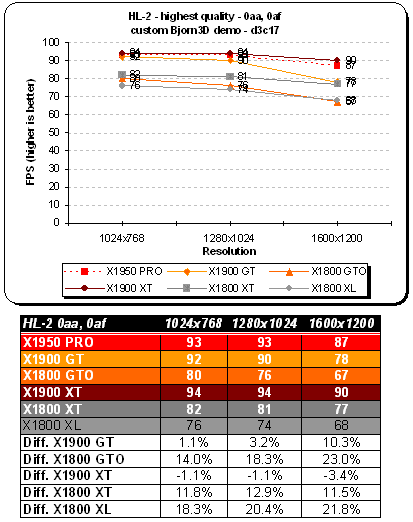
Far Cry 1.33
The company behind this game is Crytek. It was pretty much the first title which used a heavy load of PS 2.0 shaders. For our benching purposes we are using the full version with the newest 1.33 patch applied. Anyone who played this title will admire the draw distance, beautiful outside vegetation and incredibly spooky indoor environment. The game also features topnotch self-learning A.I and very realistic physics.
Far Cry’s CryEngine is pretty scalable, however you’d need at least DirectX 8 class hardware to enjoy the refractive water effects, ripples, real time per-pixel lighting, specular bump-mapping or volumetric effects.
The map of choice was Research. It’s a high-polygon map with both outdoor and indoor environment.
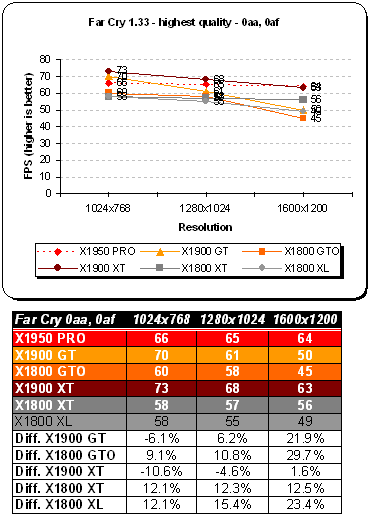
Doom 3
Although this game needs no introduction, I will go over some of the game features and technology behind Doom 3. It took the guys at id Software over four years to complete this project. Lead programmer, John Carmack spent an awful lot of time designing the game engine, but his hard work paid off — to some extent since this is first title which houses Doom 3 engine.
Let’s look at some of the engine tech features which are present in Doom 3:
- Unified lightning and shadowing engine
- Dynamic per-pixel lightning
- Stencil shadowing
- Specular lightning
- Realistic bumpmapping
- Dynamic and ambient six-channel audio
However you look at it, Carmack’s lightning engine is the essence of Doom 3. With OpenGL being the primary API, shaders have been put to a heavy use in order to create the realisticly looking environment. Instead of using lightmaps the game engine now processes all shadows in real-time. This technique is called stencil shadowing which can accurately shadow other objects in the scene. There are disadvantage to this method however:
- Requires a lot of fillrate
- Fast CPU is needed for shadow calculations
- Inability to render soft shadows
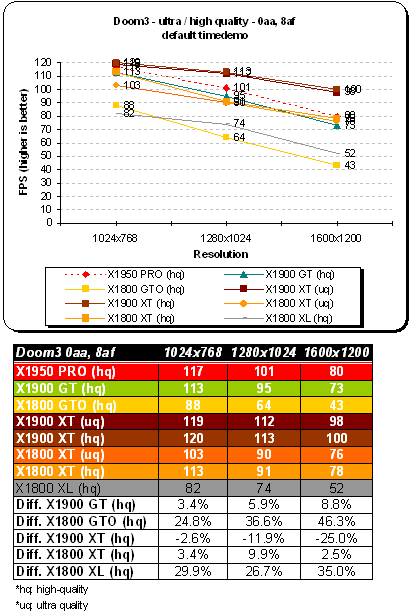
Quake 4
This is another good title worth looking at. With success of Quake 3, id Software decided (after few years) it would be proper to have a sequel. Designed over at Raven Software’s farm, Q4 features rich single player as well as intensive and popular multiplayer mode.
It uses Doom 3 engine so you should be familiar with available effects. In any case, I listed them below
- Unified lightning and shadowing engine
- Dynamic per-pixel lightning
- Stencil shadowing
- Specular lightning
- Realistic bumpmapping
- Dynamic and ambient six-channel audio
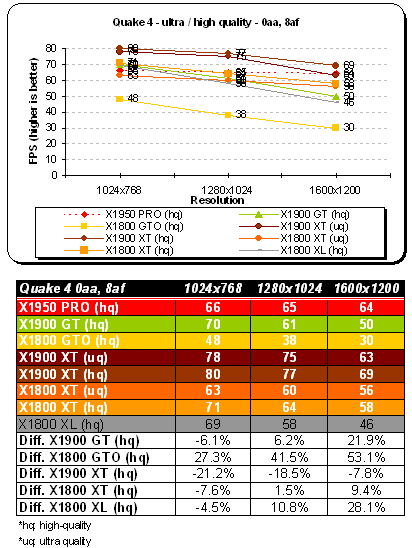
Need For Speed: Most Wanted
We have quite a few new titles in this review. This one is from Electronic Arts. If you’ve played NFS Hot Pursuit you know what I’m talking about. There are a lot of ideas taken out from the older NFS. The main difference between Most Wanted and Underground (in terms of graphics) is addition of HDR-type effects. It’s pseudo-HDR (more like bloom), but looks lovely nonetheless. Additionally the game sports flashy new reflections, better object geometry, improved lightning system and finally physics engine.
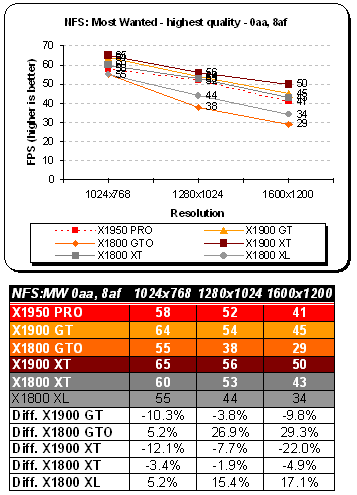

Overclocking & Conclusions
You probably remember our PowerColor X1900 GT gem and its overclocking potential. The memory on that card OC’ed from default 600 MHz to 873 MHz — free of artifacts and other anomalies. When writing this article only RivaTuner carried X1950 support, though I haven’t had a chance to use it. Instead I’ve used ATI’s own WinClk overclocking utility to bump up the speeds on PowerColor X1950 PRO. The card’s default clocks are 600 MHz core and 700 MHz memory (1400 MHz DDR). Interesting to note is that ATI reference board is clocked 575 MHz / 690 MHz memory. Seems PowerColor did a little bump out of the box. Anyway, getting to the point. I was able to push the card to 621 MHz for the GPU and 770 MHz on memory (1540 MHz DDR). Those aren’t super figures, but SAMSUNG K4J55323QG-BC14 memory chips rated at maximum of 700 MHz did well.
Let’s see how that translates into some numbers.
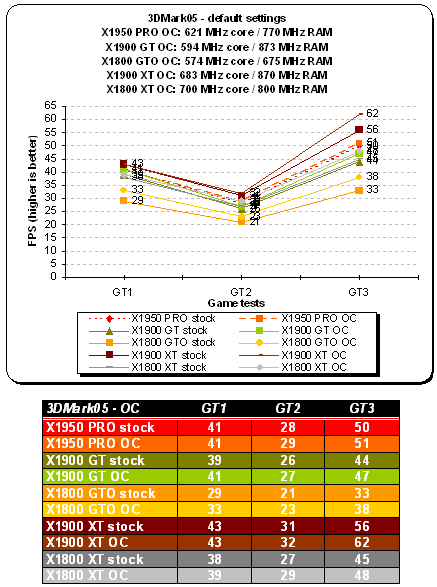
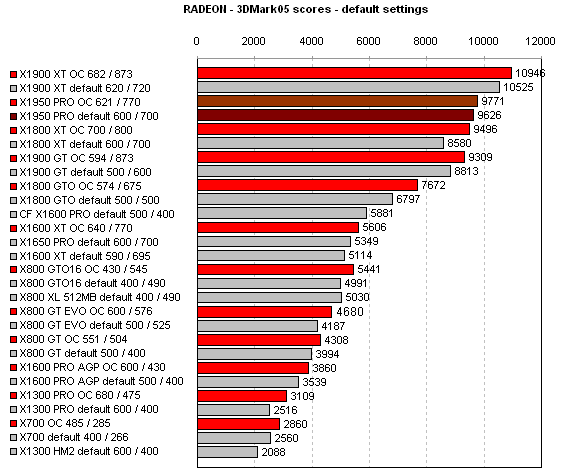
Back to PowerColor X1950 PRO. If you were to buy X1800 XT, but don’t have enough money get X1950 PRO with native CrossFire support. Later on get another one of those and you’ll be set for a long time. Getting X1900 GT instead would not be such a great choice as it performs worse and doesn’t carry new CrossFire support. Not to mention it runs hotter as its built around 90 nanometer process. Additionally if you are tired of loud cooling solutions this X1950 PRO is right for you.
ATI will soap your eyes with their new middle end cards to maintain the already decreasing distance to NVIDIA. That’s great considering you — the buyer — will benefit the most. The good thing is they aren’t just rebranding old chips from previous SKUs. RADEON X1950 PRO is NOT a respin. I myself consider PowerColor X1950 PRO 256MB a steal for $229. It plays my games smoothly, it’s quiet and cool and I can buy another one of those without the need for external dongle or master card — this wasn’t possible with let’s say X1800 XT or X1900 GT.
Pros:
+ 36 Pixel Shader Units
+ 80 nanometer process = cool, less power
+ Uses Arctic Cooling Accelero X2
+ Native CrossFire support = no dongle, master card
+ VIVO
+ Good price
Cons:
– Dual slot design
For outstanding performance in its class, native CrossFire support, PowerColor X19500 PRO gets the rating of 9.5 (Extremely Good) out of 10 and Bjorn3D.com Golden Bear Award
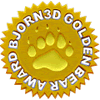
 Bjorn3D.com Bjorn3d.com – Satisfying Your Daily Tech Cravings Since 1996
Bjorn3D.com Bjorn3d.com – Satisfying Your Daily Tech Cravings Since 1996



















